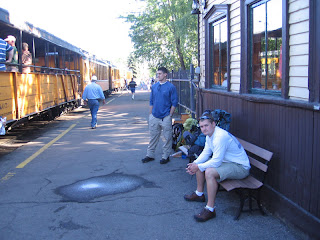 It is the most beautiful place in Colorado, a state that already boasts the most spectacular scenery in the continental United States. The Chicago Basin is an area of pristine wilderness in the middle of the San Juan Mountains in the southwestern part of the state. One of the reasons for its unspoiled condition is that it is only accessible by foot and then only after first taking a train ride from either Durango or Silverton. The closest road is many miles away.
It is the most beautiful place in Colorado, a state that already boasts the most spectacular scenery in the continental United States. The Chicago Basin is an area of pristine wilderness in the middle of the San Juan Mountains in the southwestern part of the state. One of the reasons for its unspoiled condition is that it is only accessible by foot and then only after first taking a train ride from either Durango or Silverton. The closest road is many miles away. The world-famous Durango & Silverton Narrow Gauge Railroad stops to drop off climbers and backpackers in the ghost town of Needleton, near the intersection of the Animas River and Needle Creek, at an elevation of 8200 feet. After crossing the footbridge over the Animas River, it takes a six-mile hike along Needle Creek, with about a 2500-foot elevation gain, to get up into the basin.
The world-famous Durango & Silverton Narrow Gauge Railroad stops to drop off climbers and backpackers in the ghost town of Needleton, near the intersection of the Animas River and Needle Creek, at an elevation of 8200 feet. After crossing the footbridge over the Animas River, it takes a six-mile hike along Needle Creek, with about a 2500-foot elevation gain, to get up into the basin.The trail was originally built by the Civilian Conservation Corps during the Great Depression, and it is well maintained to this day, but it is still a grueling grunt. Having hauled a heavy pack up it twice before, I packed as lightly as possible last weekend when I returned for the first time in fourteen years, along with my neighbor Rich, his stepsons Wes and Miles, and Wes's friend Rich. This was a second annual trip for Rich, Wes, Rich and me after our Rim-to-Rim Grand Canyon hike last June, with Miles filling in for Jake this year.
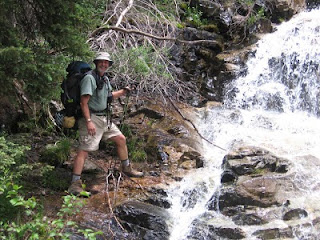 By mid-afternoon on Saturday, we had reached the upper part of the basin, where the good campsites are located. There is a recent restriction on camping within one hundred feet of any water, so the campsite I stayed at with Dave Beckwith back in 1996, which we checked out along the way, was not usable. This turned out to be a good thing, because as we walked further up the trail, we spotted the basin's renowned mountain goats on the hillside above the creek. The goats are not indigenous; they were transplanted from Glacier National Park in Wyoming at about the same time that the trail was built in the 1930s. They are thrilling to see in the wild and add incredible charm to this already magnificent area.
By mid-afternoon on Saturday, we had reached the upper part of the basin, where the good campsites are located. There is a recent restriction on camping within one hundred feet of any water, so the campsite I stayed at with Dave Beckwith back in 1996, which we checked out along the way, was not usable. This turned out to be a good thing, because as we walked further up the trail, we spotted the basin's renowned mountain goats on the hillside above the creek. The goats are not indigenous; they were transplanted from Glacier National Park in Wyoming at about the same time that the trail was built in the 1930s. They are thrilling to see in the wild and add incredible charm to this already magnificent area.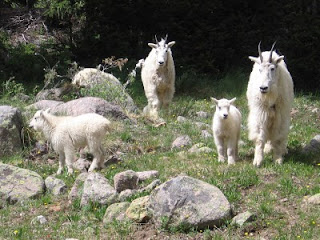 Instead of shying away from us, the goats came down to investigate. Some in our group were afraid they would be head-butted, but the goats were only curious and came right up to us as we stood on the trail taking numerous photos. They moved on after a while, and we continued up the trail to a good campsite with easy access to the creek. As we were setting up our tents, the goats returned and wandered around our camp until they located a place at the edge where Miles had urinated. They pawed the ground and ate the wet dirt! It was gross to think about, but they were obviously craving the salt in the urine. With a group of five men, it wasn't long before we had marked most of our perimeter, and the goats started to fill up our campsite, but the novelty of having them so close by never wore off.
Instead of shying away from us, the goats came down to investigate. Some in our group were afraid they would be head-butted, but the goats were only curious and came right up to us as we stood on the trail taking numerous photos. They moved on after a while, and we continued up the trail to a good campsite with easy access to the creek. As we were setting up our tents, the goats returned and wandered around our camp until they located a place at the edge where Miles had urinated. They pawed the ground and ate the wet dirt! It was gross to think about, but they were obviously craving the salt in the urine. With a group of five men, it wasn't long before we had marked most of our perimeter, and the goats started to fill up our campsite, but the novelty of having them so close by never wore off. We played sheepshead, ate dinner, and then played more sheepshead until it started to get dark and cold. The goats finally went to wherever it is that they sleep and we retired to our tents. The next morning, the sun didn't reach our campsite until almost 8:30, and no one was in a hurry to get back on the trail until things warmed up. The day's plan called for all of us to hike up to Twin Lakes, in the upper basin that separates the area's three Fourteeners, Sunlight Peak, Windom Peak and Mount Eolus, which I had climbed with Dave Beckwith during our two previous trips. After appreciating the moonscape-like vistas and figuring out their routes, the others would climb Sunlight and Windom while I returned to camp, packed up, hiked out, and caught the train back to Durango so I could be back at work on Monday morning. The others would go back to camp after their climbs, return to climb Eolus and its subpeak, North Eolus, the next day, and then hike out on Tuesday.
We played sheepshead, ate dinner, and then played more sheepshead until it started to get dark and cold. The goats finally went to wherever it is that they sleep and we retired to our tents. The next morning, the sun didn't reach our campsite until almost 8:30, and no one was in a hurry to get back on the trail until things warmed up. The day's plan called for all of us to hike up to Twin Lakes, in the upper basin that separates the area's three Fourteeners, Sunlight Peak, Windom Peak and Mount Eolus, which I had climbed with Dave Beckwith during our two previous trips. After appreciating the moonscape-like vistas and figuring out their routes, the others would climb Sunlight and Windom while I returned to camp, packed up, hiked out, and caught the train back to Durango so I could be back at work on Monday morning. The others would go back to camp after their climbs, return to climb Eolus and its subpeak, North Eolus, the next day, and then hike out on Tuesday. The climb from our campsite to Twin Lakes was as difficult as I remembered it, maybe more so, even though I was using trekking poles to help ease the strain on my knees. I must be getting old. A few times along the trail, I thought to myself that I was happy I wasn't climbing the peaks again. It was enough just to see them once more from the lakes. I wondered if Nan would want to join me on another trip to the area someday. Places this beautiful need to be shared.
The climb from our campsite to Twin Lakes was as difficult as I remembered it, maybe more so, even though I was using trekking poles to help ease the strain on my knees. I must be getting old. A few times along the trail, I thought to myself that I was happy I wasn't climbing the peaks again. It was enough just to see them once more from the lakes. I wondered if Nan would want to join me on another trip to the area someday. Places this beautiful need to be shared.Happy birthday, Dad!

 Raising Charlie: The Lessons of a Perfect Dog
Raising Charlie: The Lessons of a Perfect Dog



 Photograph of Little Walk as seen from the starboard bow, taken at the time of survey on 4/26/2010.
Photograph of Little Walk as seen from the starboard bow, taken at the time of survey on 4/26/2010.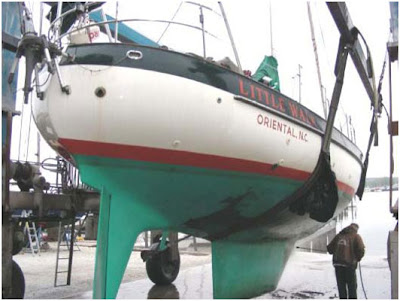 Photograph of Little Walk as seen from the starboard quarter, taken at the time of survey haul-out on 4/26/2010.
Photograph of Little Walk as seen from the starboard quarter, taken at the time of survey haul-out on 4/26/2010. Photograph of Little Walk as seen from the port bow, taken at the time of survey haul-out on 4/26/2010.
Photograph of Little Walk as seen from the port bow, taken at the time of survey haul-out on 4/26/2010.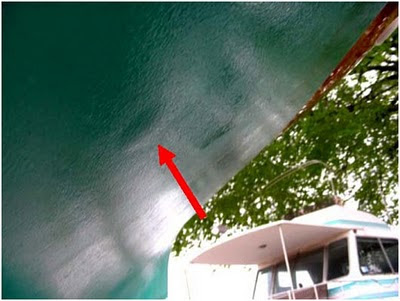 Photograph of a blister on the port aft hull bottom, taken at the time of survey on 4/26/2010. Blisters up to 3” diameter were found randomly throughout the hull finishes.
Photograph of a blister on the port aft hull bottom, taken at the time of survey on 4/26/2010. Blisters up to 3” diameter were found randomly throughout the hull finishes.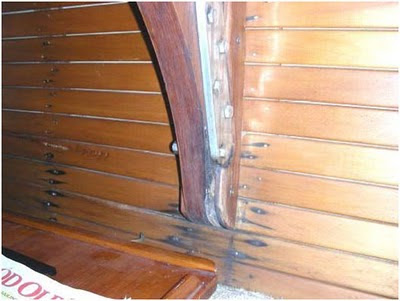 Photograph of a port cap shroud chainplate attachment to its plywood knee. The knee has deterioration along its bottom and there is likely crevice corrosion of the chainplate. All of the shroud chainplates need removal and inspection.
Photograph of a port cap shroud chainplate attachment to its plywood knee. The knee has deterioration along its bottom and there is likely crevice corrosion of the chainplate. All of the shroud chainplates need removal and inspection. Photograph of engine exhaust as seen from the starboard side, taken at the time of survey on 4/26/2010. The insulated piping is deteriorated, and there is minimal vertical separation between the point of seawater injection and the waterlift muffler.
Photograph of engine exhaust as seen from the starboard side, taken at the time of survey on 4/26/2010. The insulated piping is deteriorated, and there is minimal vertical separation between the point of seawater injection and the waterlift muffler.




